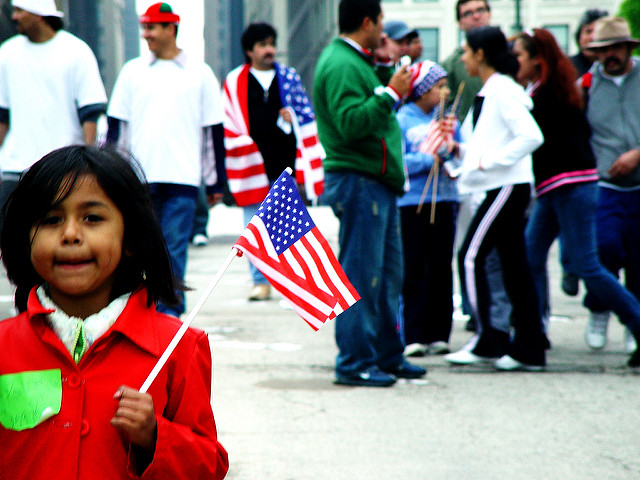The Chaos of Trump’s Would-Be Birthright Citizenship Order
In an interview with Axios released on the morning of Tuesday, Oct. 30, President Trump indicated plans to sign an executive order revoking birthright citizenship—returning to a proposal he floated early in the 2016 Republican presidential primary.

Published by The Lawfare Institute
in Cooperation With

In an interview with Axios released on the morning of Tuesday, Oct. 30, President Trump indicated plans to sign an executive order revoking birthright citizenship—returning to a proposal he floated early in the 2016 Republican presidential primary. Within hours, Vice President Mike Pence told Politico that the president is looking into legal avenues to “reconsider birthright citizenship,” arguing that “the Supreme Court of the United States has never ruled that the language of the Fourteenth Amendment … applies specifically to people who are in the country illegally.” And in July 2018, a former Trump administration national security official penned an op-ed in the Washington Post arguing that “the notion that simply being born within the geographical limits of the United States automatically confers U.S. citizenship is an absurdity.”
Many observers are dismissing the idea as half-baked—pure politics meant to stir up the president’s base just days before the midterm elections. We hope they are right. But if we have learned anything from the past 21 months of the Trump presidency, it’s that the legal and practical implausibility of an idea is no guarantee that this administration won’t attempt it.
A focus on immigration and citizenship has long been a staple of the president’s policies and rhetoric. He ran on the fear of violence that might be perpetrated by undocumented immigrants from Mexico and Central and South America. He has capped refugee admissions at record lows for 2018 and 2019 and expressed a desire to end what he refers to as “chain migration,” known otherwise as family-based immigration as established under the Immigration and Nationality Act. He directed the implementation of the one hundred percent prosecution of illegal entry at the U.S.-Mexico border, which—due to lack of policy planning—was carried out by forcibly separating children from their parents or guardians. More recently, he minimized the significance of the murder of journalist Jamal Khashoggi in the Saudi Arabian consulate in Turkey by repeatedly stating that Khashoggi was “not a citizen.” (Khashoggi was, significantly, a legal resident of the United States, which status afforded him many legal rights under U.S. law that are afforded to citizens.) And now the president and vice president have said the administration is considering legal avenues for limiting birthright citizenship.
There are many reasons not to credit the proposal on birthright citizenship as a substantive policy plan—to begin with, that it emerged most recently in a comment by the president in response to a leading question by a reporter. There is no indication that the Justice Department or the Department of Homeland Security have participated in such a policy development. What’s more, as Michel Paradis wrote on Lawfare when Trump first floated this scheme in 2015, “ending birthright citizenship will require a constitutional amendment or a judicial abandonment of what [the Fourteenth Amendment] meant when it was written.” Apart from a tiny handful of scholars or policy professionals—including, apparently, former National Security Council spokesman Michael Anton—the vast majority of the legal academy agrees that the language of the Fourteenth Amendment ensures birthright citizenship, a principle affirmed in the Supreme Court’s 1898 ruling in United States v. Wong Kim Ark.
In 1995, Walter Dellinger, then the head of the Office of Legal Counsel, testified before Congress on the Justice Department’s view that any action to limit birthright citizenship would be facially unconstitutional. Dellinger noted on Tuesday that this position “has never been publicly called into question.” Indeed, we have no indication that the Office of Legal Counsel has weighed in on Trump’s proposal at all. We are comfortable with the consensus view that an executive order restricting birthright citizenship, even just for the children of undocumented immigrants, would be almost certain to fail in court—even if it got past the Office of Legal Counsel.
But while the president can’t unilaterally revise the Constitution and overturn over one hundred years of Supreme Court precedent, he can still create an enormous mess by trying.
We are reminded of the travel ban experience, about which we have written previously on Lawfare. Recall the weekend of Jan. 28, 2017, when the first travel ban was issued. In addition to preventing admission to the United States by individuals from select countries, provisions of the original order included references to permanent resident aliens—that is, non-citizens with lawful status, sometimes referred to as green card holders. Travelers were stranded in airports, uncertain of whether they would be able to enter the country. U.S. citizens were detained hours longer than they should have been. Travel plans were disrupted and families endured stress they should not have had to endure. The order was legally sloppy and involved minimal interagency coordination, to the point where the Department of Homeland Security was briefed on the ban only as the president was signing it. It was enjoined by federal district courts across the country within hours of going into effect—but its carelessness caused a great deal of chaos in the meantime.
We are similarly reminded, as we have also written, of the family separation policy. Perhaps even crueler than the original travel ban in its use of children as pawns to make a political point, the implementation of the family separation policy was at first draconian, and later, confused. The initial “zero-tolerance policy” that instigated the separation of parents and children transformed amid political crisis into a “hastily written” executive order, which ostensibly did not mandate family separation but did not provide a clear path to reunification either. The result is that months after the president signed an order that would supposedly keep families together, the process of reuniting children with parents and guardians has been slow, inadequate and remains unfinished. To this day, the consequences of both the original policy and its confused on-and-off status have resulted in the continued separation of some families—and most likely, lifelong trauma for some of the children involved.
Like the travel ban, the family separations executive order rested on shaky legal ground and immediately faced legal challenges. Perhaps the administration has learned from its mistakes and is putting more thought into the apparent effort to curtail birthright citizenship, but that doesn’t mean the consequences would not be as disruptive. And even if the lawyering were as shoddy as the administration’s past efforts and the fringe nature of the underlying legal analysis involved would suggest, the twin experiences of the travel ban and the family separations policy show that it could still do a lot of damage.
Once the president signed an executive order along these lines, it could go into effect immediately. It would likely take several hours for legal challenges to the constitutionality of the order—probably being drafted as we write this—to be filed in federal court. A judge would need to read the challenge, and rule. This could take hours, or more.
One thing is certain: during the time it takes for a challenge to be filed and for a judge to hand down a ruling, children will be born in the United States. And the legal status of those babies born to undocumented parents will undoubtedly be in question if the president’s order is in place. A new class of children—this time, infants—will immediately be thrust into administrative and legal uncertainty. Additional burdens will be placed on their parents, legal aid and social services. Government agencies, such as the Social Security Administration, Department of Homeland Security and Department of Health and Human Services will all be operating in an environment of legal ambiguity. That could include whether to initiate deportation proceedings against the parents, if undocumented, and newborn child.
The odds are very good that, within days or weeks or months, the status of these children would be settled and that they would live their lives as Americans, with all attendant rights and privileges. But the fact that there is even a possibility that their status could be in question, for the first time since the 19th century, is damage enough. The Trump administration’s legal carelessness apparently extends not just to the mechanics of executive orders, but also to the safekeeping of birthright citizenship as one of the United States’s most dearly held constitutional traditions—something that, as Dellinger testified in 1995, is “fundamental to our liberty as we understand it.”



.png?sfvrsn=48e6afb0_5)


